|
|
|
Sort Order |
|
|
|
Items / Page
|
|
|
|
|
|
|
| Srl | Item |
| 1 |
ID:
124670
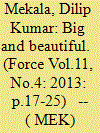

|
|
|
|
|
| Publication |
2013.
|
| Summary/Abstract |
INS Vikramaditya, the floating airfield, has an overall length of about 284 metres and a maximum beam of about 60 metres, stretching as far as three football fields put together. Standing about 20 storeys tall from keel to the highest point, this massive 44,500 tonne ship will be the biggest ship that will be operated by the Indian Navy. The ship has a total of 22 decks.
Vikramaditya in its earlier avatar with the Russian Navy as the Kiev class aircraft carrying cruiser 'Baku' was capable of operating fixed wing Vertical Takeoff and Landing (VTOL) fighters. The task of breathing life and converting the ship from a VTOL missile cruiser carrier to a short take off but arrested recovery (STOBAR) aircraft carrier involved substantial degutting, equipment removal, refit and re-equipping. The major works included modification of flight deck to include ski-jump and arrester gear; modification of bulbous bow, aft aircraft lift and ammunition lifts; modification of 1,750 out of 2,500 compartments; installation of new main boilers; installation of new and additional diesel generators; replacement of existing distilling plants; fitment of Reverse Osmosis plants, new AC plants and Refrigeration plants and installation of new sensors and equipment. "More than 80 per cent of the equipment fitted into the ship is new," said an Indian Navy officer.
Creation of the flight deck with structural modification to convert the VTOL carrier to a STOBAR carrier was apparently the most intricate and arduous. The task involved installation of Sponsons to increase the breadth at the Flight Deck and a fitment of a new 14 degree ski jump, strengthening of arresting gear area, strengthening of runway area and elongation of the aft end to generate the required length of landing strip aft of the arresting gear. In all 234 new hull sections were installed to achieve the desired shape.
|
|
|
|
|
|
|
|
|
|
|
|
|
|
|
|
| 2 |
ID:
124673


|
|
|
|
|
| Publication |
2013.
|
| Summary/Abstract |
At the heart of India's ambition towards becoming a global power is the idea of maritime dominance. The global strategic environment, just like the economic pendulum, over the past decade is shifting inexorably from west to east, which is represented by the increasing presence of the US in the seas to our east. The United States is also rebalancing its resources, especially its naval power in the seas surrounding Asian countries. "This, to my mind, is a development fraught with uncertainty. We don't yet know whether these economic and strategic transitions will be peaceful, but that is the challenge this audience must grapple with institutionally," Prime Minister Manmohan Singh cautiously warned at the Combined Commander's conference in November.
"India's growing international stature gives it a strategic relevance in the area ranging from the Persian Gulf to the Straits of Malacca… India has exploited the fluidities of the emerging world order to forge new links through a combination of diplomatic repositioning, economic resurgence and military firmness," stated the Prime Minister Manmohan Singh at a different event.
The increasing globalisation further emphasises the importance of sea for a country's development. It would be interesting to note that 90 per cent of Indian trade by volume and a bulk of its energy imports happen via the sea route. Over 97 per cent of our energy needs of the oil are either imported or produced from offshore fields. In this age of the sea, the Indian Navy assumes paramount responsibility of ensuring hassle-free trade as well as maritime security for the country. It is also important to ensure friendly and cordial relations with all neighbouring countries which are connected via the sea route.
|
|
|
|
|
|
|
|
|
|
|
|
|
|
|
|
| 3 |
ID:
125992


|
|
|
|
|
| Publication |
2013.
|
| Summary/Abstract |
Chairman, Saab India Technologies Pvt. Ltd, Lars-Olof Lindgren's first year in the new job has been exciting albeit a bit slow. But an old India hand (he was Swedish ambassador to India for five years from 2007-2012), Lindgren understands that in India lack of speed is not such a bad thing. On the contrary, it may even be a good thing as it gives time for repeated confabulations and, who know, reconsiderations
|
|
|
|
|
|
|
|
|
|
|
|
|
|
|
|
| 4 |
ID:
125979
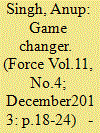

|
|
|
|
|
| Publication |
2013.
|
| Summary/Abstract |
The commissioning of the ex Gorshkov as INS Vikramaditya last month, was not just path breaking for the Indian Navy (IN) but more significantly for this important maritime nation. Many prophets of doom had predicted a 'dead bargain' and 'unrealistic time and cost overruns' as the forerunner of uncertainty for the future of naval aviation. They stand proven wrong.
Vikramaditya is not about keeping the art of carrier-aviation 'alive' for India (that was never in peril); nor was it a mere case of the current carrier being replaced. The 45,000 tonne Vikramaditya is about power projection, as against just air defence of the fleet, and, force projection that Light aircraft carriers are capable of. So, where are we and what does Vikramaditya bring with her? Well, we are somewhere there and she will surely be a game changer after a long, long time.
|
|
|
|
|
|
|
|
|
|
|
|
|
|
|
|
| 5 |
ID:
124678
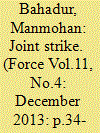

|
|
|
|
|
| Publication |
2013.
|
| Summary/Abstract |
India had its most famous victory in December 1971 while resolving the geo-political absurdity of the British when they left India and made two culturally different entities of West Punjab and East Bengal under a single nation called Pakistan. It had to go one day, and in its dismemberment the Indian armed forces had their most famous hour too. While the formation of Bangladesh was the proverbial icing on the cake, what also emerged was the synergy amongst the three Services as the overall plan was put in action. Sure, there were some mismatches, but that can be expected when a war plan rolls into action.
While the joint role of the Indian Air Force (IAF) and the Indian Army (IA) in the Bangladesh war is well known, knowledge of the combined efforts of the IAF and the Indian Navy are conspicuous by their absence. To be sure, they were few due to the totally different directions of approach and the fact that there was no amphibious operation. But that was way back in 1971. What the future holds for IAF-Indian Navy (IN) operations on our Eastern sea board in the Bay of Bengal and the adjoining portion of the Indian Ocean is the aim of this essay.
|
|
|
|
|
|
|
|
|
|
|
|
|
|
|
|
| 6 |
ID:
125999
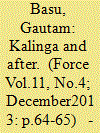

|
|
|
|
|
| Publication |
2013.
|
| Summary/Abstract |
In the episode of our chronicle of war and, civilization, we study the impact of Kalinga war on India's history and meet the military dynasties that succeeded the Mauryaas
|
|
|
|
|
|
|
|
|
|
|
|
|
|
|
|
| 7 |
ID:
124675
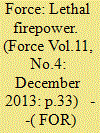

|
|
|
|
|
| Publication |
2013.
|
| Summary/Abstract |
The maritime prowess of India is witnessing impressive advancements at a time when the Indian Navy is undergoing a complete transformation to reincarnate itself into a 'Blue Water' force and project its power and reach far beyond the littoral waters.
In the wake of rapidly evolving global strategic equations with a heightened focus on the Asia-Pacific region, India is gearing up to not only strengthen and secure its position in its backyard - the crucial Indian Ocean Region (IOR), but also venturing out far beyond - from the Horn of Africa and Red Sea in Asia/Africa to the Western Mediterranean in Europe
|
|
|
|
|
|
|
|
|
|
|
|
|
|
|
|
| 8 |
ID:
124671
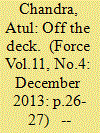

|
|
|
|
|
| Publication |
2013.
|
| Summary/Abstract |
The induction of three vitally important types (MiG-29K, P-8I and Hawk Mk-132) into Indian naval aviation this year marks a resurgence of Indian naval air power in the region. Indian Naval Air Squadron (INAS) 303 'Black Panthers' was commissioned as the first MiG 29K squadron of the Indian Navy (IN) at INS Hansa in Goa in May this year (with 12 MiG-29K single seaters and four MiG-29KUB twin seaters). The same month saw the Indian Navy's first Boeing P-8I Long Range Maritime Reconnaissance (LRMR) and Anti-Submarine Warfare (ASW) aircraft arriving at NAS Rajali, at Arakkonam (in Tamil Nadu).
Last month, the IN inducted its first Hawk Mk-132 Advanced Jet Trainers (AJT) at NAS Dega. Hindustan Aeronautics Limited (HAL) has already delivered the first four jet trainers to the IN. The remaining 13 aircraft will be delivered over the next few years, completing the 17 aircraft order. The MiG-29 K/KUB and Boeing P-8I will enable the IN to provide credible and timely deterrence against its adversaries over the seas, while the induction of the first batch of BAE Hawk Mk-132 AJT will provide a state-of-the-art training environment for pilots transitioning to the MiG-29 Ks and much later the Light Combat Aircraft (LCA) navy fighter.
The MiG-29 K (single seat fighter) and MiG-29 KUB (twin seat fighter) multirole carrier borne fighter will provide the IN with a fighter that can strike both land and air targets and be used for long-range fleet air defence. Importantly, they will be able to commit to a much larger radius of action compared to the Sea Harriers, along with a substantially higher weapon load that can be delivered with much higher accuracy. Another fact that must be noted is the one can expect far more numbers of the MiG-29K to remain in service three decades from now, when compared to the notoriously difficult-to-fly Sea Harrier (which has suffered high attrition).
All 29 MiG-29 Ks on order (worth USD 1.5 billion) will be delivered by 2015 and currently 21 fighters have been delivered to the IN, the type having flown more than 2,500 hours since the first aircraft was inducted in February this year. The IN is the first user of the MiG-29 K; the Russian Navy has just become the second operator, taking delivery of its first four MiG-29K/KUB jets (two single-seat and two twin-seat) last month. Twenty MiG-29K and four MiG-29KUB fighters are to be delivered by 2015, and will be deployed on Russia's sole aircraft carrier 'Admiral Kuznetsov'.
|
|
|
|
|
|
|
|
|
|
|
|
|
|
|
|
| 9 |
ID:
125986
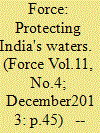

|
|
|
|
|
| Publication |
2013.
|
| Summary/Abstract |
Eurocopter's AS565 MB Panther provides a highly capable solution for planned helicopter acquisitions by the Indian Navy (IN) and Indian Coast Guard (ICG), offering a force multiplier with an excellent record that benefits from a heritage of mission-proven rotorcraft in service with military forces worldwide.
|
|
|
|
|
|
|
|
|
|
|
|
|
|
|
|
| 10 |
ID:
124669
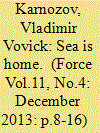

|
|
|
|
|
| Publication |
2013.
|
| Summary/Abstract |
Relief and joy reigned in the hearts of the Russian shipbuilders, arms sellers and political leaders following the commissioning of Project 11430 aircraft carrier - the painful programme that long hampered relations with strategic partner India through repeated delays and cost escalations, is finally over.
For the Indians, who attended the handover ceremony in Severodvinsk on November 16, the historical day could not be spoilt by the freezing cold weather. It was a proud moment for them as their 'dream carrier', INS Vikramaditya, finally set sail for home.
As early as 8:30 in the morning, seamen in parade uniform had gathered at the Sevmash main jetty along the ship's starboard side, well before dignitaries and military leaders trooped in. Indian Navy's Admiral Devender Kumar Joshi, Chief of the Naval Staff, was one of the early ones to arrive. It was only after the arrival of Indian defence minister A.K. Antony, the centre of attention shifted to the carrier's flight deck, where tents for dignitaries, invited guests and media had been erected. Nearly half-a-dozen speakers addressed the gathering that day, including Russian deputy prime minister (vice premier responsible for the military industrial complex) Dmitry Olegovich Rogozin. But all eyes and ears were set on India's defence minister. The question uppermost on everybody's mind was, 'Is he happy'? Also, many wondered whether the Indian ministry of defence would continue its partnership with Russian suppliers or choose to go with other collaborators in the US and Europe who were desperate to have a share of the growing Indian military budget?
|
|
|
|
|
|
|
|
|
|
|
|
|
|
|
|
| 11 |
ID:
125989
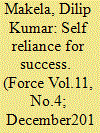

|
|
|
|
|
| Publication |
2013.
|
| Summary/Abstract |
India is planning to spend USD 150 billion for the Indian Air Force (IAF) acquisitions in the next 15 years. With such high spending by the government envisaged, it is only logical to push for the indigenous capabilities in the aerospace industry. Hindustan Aeronautics Limited (HAL) is the only active aerospace manufacturer in India currently, and although it started well with Marut and Intermediate Jet trainers, the design capabilities fell drastically over the years. It is unfortunate that the Indian industry can't even provide basic trainer aircraft to the IAF; Pilatus PC-7 is procured from Switzerland for IAF basic training purposes. "I am sad to say that we import basic equipment like the washers and the nuts," said Air Marshal P.P. Reddy, director general (Inspection and Safety) said. Of course, there are numerous challenges but at the same time many more opportunities for the aerospace industry. For example, the involvement of Indian private sector in the co-development and co-production with the global leaders can make a lot of difference. Sadly, there is no backing from the policy makers.
|
|
|
|
|
|
|
|
|
|
|
|
|
|
|
|
| 12 |
ID:
126006


|
|
|
|
|
| Publication |
2013.
|
| Summary/Abstract |
As 2013 ends, the Indian Air Force (IAF) and the Indian Navy (IN) can look back at a year that saw a number of new aircraft being inducted; bringing both services closer to their modernisation goals. For the IAF, large scale exercises such as 'Iron Fist' and 'Live Wire' were ideal platforms to test new tactics and plans. Rescue operations mounted as part of 'Operation Rahat' showcased some of the IAF's latest platforms in what was a lifesaving performance during the Uttarakhand calamity. The IN has also seen a resurgence in the capabilities of its air arm and the service itself was involved in a number of exercises with international navies.
|
|
|
|
|
|
|
|
|
|
|
|
|
|
|
|
| 13 |
ID:
124672


|
|
|
|
|
| Publication |
2013.
|
| Summary/Abstract |
Over the years the naval air arm has grown from a modest force to a full-fledged operational arm with an inventory of more than 200 aircraft. These include fighters, helicopters, maritime reconnaissance aircraft and Unmanned Aerial Vehicles (UAVs) with the capability to support the entire spectrum of maritime operations covering all dimensions of naval warfare. The navy's air arm operates from aircraft carriers, ships and a large number of naval airfields located across the Indian Littorals.
In May this year, naval aviation marked its 60 years of existence with the commissioning of its Air Squadron (Black Panthers) equipped with MiG 29K fighter jets for Carrier borne operations. This was followed by the induction of Boeing P-81 Poseidon MR-ASW aircraft and finally, in a historic development with far-reaching operational consequences, the Indian Navy took delivery of INS Vikramaditya. The acquisition of this 44,570 tonne carrier marks a new phase in India's quest to become a true blue water navy and is likely to have generated more than a passing interest within the People's Liberation Army Navy (PLA Navy) and across the rest of the Continent. These developments will place the Indian Navy at par with Russian and US navies as far as hardware is concerned.
In the fighter jet category for operating out of aircraft carriers, the naval aviation has two squadrons of the Sea Harrier which operate from INS Viraat. These were acquired by the Indian Navy in the mid Eighties and these jets had also operated ex INS Vikrant. Action was initiated to get additional Sea Harrier jets from Britain when the same were decommissioned by the Royal Navy, but the proposal did not fructify due to technical glitches. The proposal for a mid-life upgrade in the late Nineties was cancelled when the decision was taken to purchase MiG-29K jet fighters to be deployed aboard the INS Vikramaditya.
As the Harriers are expected to remain in service with the navy till 2015, limited upgrades are being done by Hindustan Aeronautics Limited (HAL). The indigenously produced Kiran (jet fighter trainer), which is currently being used for training, is likely to be phased out following the induction AJT Hawk jet trainers. The Kirans have been part of the elite Naval Aerobatic Display Team, 'The Sagar Pawans'.
In the Long Range Maritime Reconnaissance stream, the navy presently operates eight Tupolev Tu-142 aircraft which entered service in 1988. Upgrade of the aircraft is in process to extend its service life. These aircraft operate from INS Rajali and INS Hansa. In the Medium Range category, the navy has the Islander aircraft inducted into the navy in 1976 - these aircraft are vintage and need immediate replacement. In the Short Range category, the navy operates the HAL-built Dornier aircraft which continues to meet the surveillance and reconnaissance requirements of the navy.
Helicopters form a key element of a naval fleet at sea due to its ability to easily operate from frigate size ships and carry out diverse roles from anti-submarine warfare (ASW) to electronic warfare (EW), airborne early warning (AEW) and search and rescue (SAR). The Indian Navy operates a helicopter fleet consisting of the Sea King (ASW), Kamov 28 and 31 (ASW) and the modified Chetak-MATCH (Mid Air Torpedo Carrying Helicopter). In addition, they have a fleet of Chetak helicopters for shipborne operations. These helicopters are old and need replacement/upgrades. The HAL manufactured Dhruv (naval variant) was inducted into the air arm in March 2002. However, the navy found the Dhruv unsuitable for its role as an ASW platform. The Kamov-31 AEW helicopters acquired from Russia in the Nineties has proved to be a versatile platform for airborne operations at sea; more numbers are likely to be inducted.
|
|
|
|
|
|
|
|
|
|
|
|
|
|
|
|
| 14 |
ID:
126007
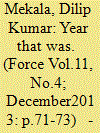

|
|
|
|
|
| Publication |
2013.
|
| Summary/Abstract |
Another eventful year is coming to an end and this time there is a lot to be cheerful about. For the defence and the paramilitary forces, the year 2013 has been fruitful in terms of their force modernisation. Even the defence industry managed to find satisfaction in some of the advances made in the long and tedious defence procurement.
On the other hand, instances of infiltration, cross border firing and border incursion from neighbouring armies cast a pall of gloom in an otherwise successful year. In addition, there were tragic and extremely challenging situations which the government and the forces faced, such as the devastating floods in Uttarakhand, INS Sindhurakshak mishap and so on. But overall, it has been an eventful year. Let's look at the major events in Indian defence in 2013.
|
|
|
|
|
|
|
|
|
|
|
|
|
|
|
|
|
|
|
|
|